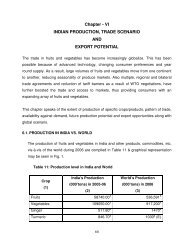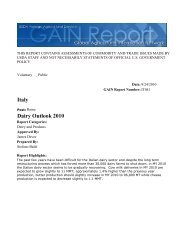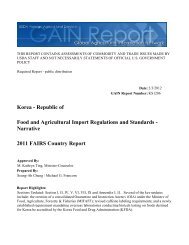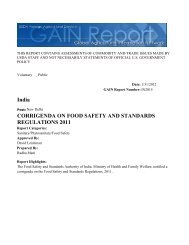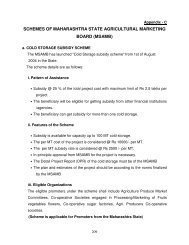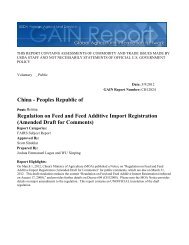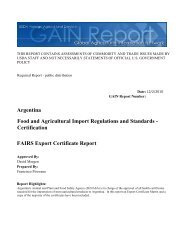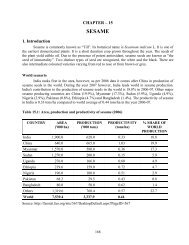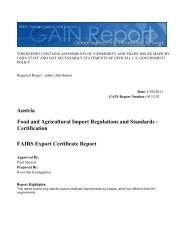Report of the Joint Study Group on the Feasibility of India-Indonesia ...
Report of the Joint Study Group on the Feasibility of India-Indonesia ...
Report of the Joint Study Group on the Feasibility of India-Indonesia ...
Create successful ePaper yourself
Turn your PDF publications into a flip-book with our unique Google optimized e-Paper software.
11<br />
Country TTRI (MFN Market Access TTRI<br />
applied tariff)*<br />
(incl. preferences)*<br />
All goods<br />
All goods<br />
===============================================================<br />
Ind<strong>on</strong>esia 50 ( 4.5) 71 ( 4.3)<br />
China 57 ( 5.3) 59 ( 3.7)<br />
South Africa 62 ( 5.7) 49 ( 3.0)<br />
Russian Federati<strong>on</strong> 72 ( 6.6) 30 ( 1.7)<br />
Brazil 92 ( 9.4) 63 ( 3.8)<br />
<strong>India</strong> 117 (15.1) 59 ( 3.7)<br />
Source: World Bank, World Trade Indicators 2008.<br />
* Rankings and figures in paren<str<strong>on</strong>g>the</str<strong>on</strong>g>ses are values.<br />
Table above lists <str<strong>on</strong>g>the</str<strong>on</strong>g> TTRI for <str<strong>on</strong>g>the</str<strong>on</strong>g> group <str<strong>on</strong>g>of</str<strong>on</strong>g> BRIICS countries (Brazil, Russian Federati<strong>on</strong>, <strong>India</strong>, Ind<strong>on</strong>esia,<br />
China and South Africa). Ind<strong>on</strong>esia has <str<strong>on</strong>g>the</str<strong>on</strong>g> lowest restrictiveness index<br />
am<strong>on</strong>gst this group <str<strong>on</strong>g>of</str<strong>on</strong>g> countries. However, it faces <str<strong>on</strong>g>the</str<strong>on</strong>g> highest Market Access TTRI, i.e. <str<strong>on</strong>g>the</str<strong>on</strong>g> equivalent<br />
tariffs <strong>on</strong> its exports globally, including preferential tariffs). This suggests <str<strong>on</strong>g>the</str<strong>on</strong>g> need for Ind<strong>on</strong>esia to push<br />
for lower tariffs from o<str<strong>on</strong>g>the</str<strong>on</strong>g>r countries through negotiati<strong>on</strong>s. The Ind<strong>on</strong>esian Minister <str<strong>on</strong>g>of</str<strong>on</strong>g> Trade, Mari<br />
Pangestu, has recently stated that this will be pursued primarily under <str<strong>on</strong>g>the</str<strong>on</strong>g> WTO, but that Ind<strong>on</strong>esia needs to<br />
get lower tariffs not <strong>on</strong>ly from developed countries, but also from such countries as <strong>India</strong> and Brazil. 2<br />
Opening Export Markets<br />
Bilateral agreements, specifically bilateral FTAs (Free Trade Agreements), are currently seen as a means to<br />
open export markets. Ind<strong>on</strong>esia has not been an active promoter and participant in forming bilateral FTAs<br />
as some <str<strong>on</strong>g>of</str<strong>on</strong>g> its neighbors in Sou<str<strong>on</strong>g>the</str<strong>on</strong>g>ast Asia. This has been <str<strong>on</strong>g>the</str<strong>on</strong>g> result <str<strong>on</strong>g>of</str<strong>on</strong>g> a l<strong>on</strong>g-held view that bey<strong>on</strong>d<br />
ASEAN (and <str<strong>on</strong>g>the</str<strong>on</strong>g> ASEAN Free Trade Area or AFTA), efforts to liberalize trade should be undertaken at <str<strong>on</strong>g>the</str<strong>on</strong>g><br />
multilateral level. Ind<strong>on</strong>esia also str<strong>on</strong>gly supports unilateral liberalizati<strong>on</strong> efforts under <str<strong>on</strong>g>the</str<strong>on</strong>g> APEC<br />
framework <str<strong>on</strong>g>of</str<strong>on</strong>g> “c<strong>on</strong>certed unilateral liberalizati<strong>on</strong>.”<br />
As <str<strong>on</strong>g>of</str<strong>on</strong>g> <str<strong>on</strong>g>the</str<strong>on</strong>g> end <str<strong>on</strong>g>of</str<strong>on</strong>g> July 2008, Ind<strong>on</strong>esia has signed five FTAs that are being implemented, namely: (a) <str<strong>on</strong>g>the</str<strong>on</strong>g><br />
ASEAN Free Trade Area (AFTA); (b) <str<strong>on</strong>g>the</str<strong>on</strong>g> ASEAN-China FTA; (c) <str<strong>on</strong>g>the</str<strong>on</strong>g> ASEAN-Korea FTA; (d) <str<strong>on</strong>g>the</str<strong>on</strong>g><br />
Ind<strong>on</strong>esia-Japan EPA (Ec<strong>on</strong>omic Partnership Agreement); and <str<strong>on</strong>g>the</str<strong>on</strong>g> ASEAN-Japan FTA. They are at<br />
different stages <str<strong>on</strong>g>of</str<strong>on</strong>g> implementati<strong>on</strong>. 3<br />
Ind<strong>on</strong>esia c<strong>on</strong>siders <str<strong>on</strong>g>the</str<strong>on</strong>g> ASEAN+1 agreements to be c<strong>on</strong>sistent with its overall external ec<strong>on</strong>omic policy<br />
that focuses <strong>on</strong> cooperati<strong>on</strong> and integrati<strong>on</strong> in ASEAN and <str<strong>on</strong>g>the</str<strong>on</strong>g> wider regi<strong>on</strong>. It appears that each bilateral<br />
agreement will by necessity be tailor made to <str<strong>on</strong>g>the</str<strong>on</strong>g> interests and needs as well as <str<strong>on</strong>g>the</str<strong>on</strong>g> circumstances <str<strong>on</strong>g>of</str<strong>on</strong>g> <str<strong>on</strong>g>the</str<strong>on</strong>g><br />
parties c<strong>on</strong>cerned. It will not be easy, <str<strong>on</strong>g>the</str<strong>on</strong>g>refore, to amalgamate <str<strong>on</strong>g>the</str<strong>on</strong>g> many bilateral FTAs involving countries<br />
in <str<strong>on</strong>g>the</str<strong>on</strong>g> regi<strong>on</strong> into a regi<strong>on</strong>-wide FTA. It is likely that a regi<strong>on</strong>-wide FTA will have to be negotiated<br />
separately (and independently) from <str<strong>on</strong>g>the</str<strong>on</strong>g> existing <strong>on</strong>es. This was <str<strong>on</strong>g>the</str<strong>on</strong>g> rati<strong>on</strong>ale behind <str<strong>on</strong>g>the</str<strong>on</strong>g> recommendati<strong>on</strong><br />
<str<strong>on</strong>g>of</str<strong>on</strong>g> <str<strong>on</strong>g>the</str<strong>on</strong>g> <str<strong>on</strong>g>Joint</str<strong>on</strong>g> Expert <str<strong>on</strong>g>Group</str<strong>on</strong>g> <strong>on</strong> EAFTA. Ind<strong>on</strong>esia and several o<str<strong>on</strong>g>the</str<strong>on</strong>g>r ASEAN countries are <str<strong>on</strong>g>of</str<strong>on</strong>g> <str<strong>on</strong>g>the</str<strong>on</strong>g> opini<strong>on</strong> that<br />
for <str<strong>on</strong>g>the</str<strong>on</strong>g> foreseeable future <str<strong>on</strong>g>the</str<strong>on</strong>g>y should still focus <strong>on</strong> <str<strong>on</strong>g>the</str<strong>on</strong>g> separate ASEAN+1 agreements ra<str<strong>on</strong>g>the</str<strong>on</strong>g>r than <strong>on</strong> a<br />
regi<strong>on</strong>-wide agreement. In additi<strong>on</strong> to signing a framework agreement with China, Korea and Japan,<br />
ASEAN is currently negotiating similar agreements with Australia and New Zealand, <strong>India</strong>, and <str<strong>on</strong>g>the</str<strong>on</strong>g><br />
European Uni<strong>on</strong>.<br />
So far, <str<strong>on</strong>g>the</str<strong>on</strong>g> <strong>on</strong>ly bilateral arrangement that Ind<strong>on</strong>esia has finalized is with Japan. Being <str<strong>on</strong>g>the</str<strong>on</strong>g> first for<br />
Ind<strong>on</strong>esia, <str<strong>on</strong>g>the</str<strong>on</strong>g> bilateral agreement with Japan may be used as a model for Ind<strong>on</strong>esia in <str<strong>on</strong>g>the</str<strong>on</strong>g> development <str<strong>on</strong>g>of</str<strong>on</strong>g><br />
o<str<strong>on</strong>g>the</str<strong>on</strong>g>r FTAs in <str<strong>on</strong>g>the</str<strong>on</strong>g> future. The Ind<strong>on</strong>esia-Japan EPA is ra<str<strong>on</strong>g>the</str<strong>on</strong>g>r comprehensive. This EPA c<strong>on</strong>tains elements<br />
that are not usually seen in an FTA, and are also new for Japan. These are <str<strong>on</strong>g>the</str<strong>on</strong>g> chapters <strong>on</strong> “Improvement <str<strong>on</strong>g>of</str<strong>on</strong>g><br />
Business Envir<strong>on</strong>ment and Promoti<strong>on</strong> <str<strong>on</strong>g>of</str<strong>on</strong>g> Business C<strong>on</strong>fidence” and “Energy and Mineral Resources”. The<br />
former is <str<strong>on</strong>g>of</str<strong>on</strong>g> interest to Ind<strong>on</strong>esia and has been included by Ind<strong>on</strong>esia to seek support from Japan in <str<strong>on</strong>g>the</str<strong>on</strong>g><br />
improvement <str<strong>on</strong>g>of</str<strong>on</strong>g> Ind<strong>on</strong>esia’s investment climate. The latter is <str<strong>on</strong>g>of</str<strong>on</strong>g> particular interest to Japan. In fact under<br />
this agreement, Ind<strong>on</strong>esia will hold prior c<strong>on</strong>sultati<strong>on</strong> with Japan about restricting oil and gas exports in <str<strong>on</strong>g>the</str<strong>on</strong>g><br />
event <str<strong>on</strong>g>of</str<strong>on</strong>g> a surge in domestic demand. Ind<strong>on</strong>esia also pledges to fully implement existing bilateral energy<br />
supply c<strong>on</strong>tracts even when export restricti<strong>on</strong>s are invoked. In return Japan will increase technical<br />
assistance in such areas as coal-to-liquid technologies and energy-saving measures.<br />
The EPA also gives some weight to “Technical Cooperati<strong>on</strong> and Capacity Building.” From <str<strong>on</strong>g>the</str<strong>on</strong>g> outset,



